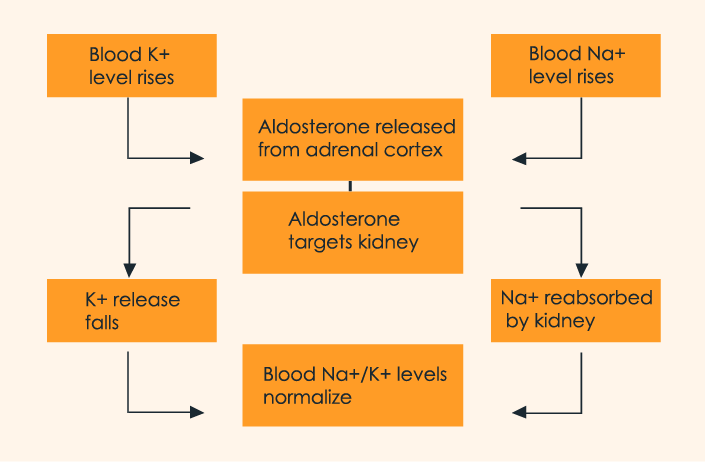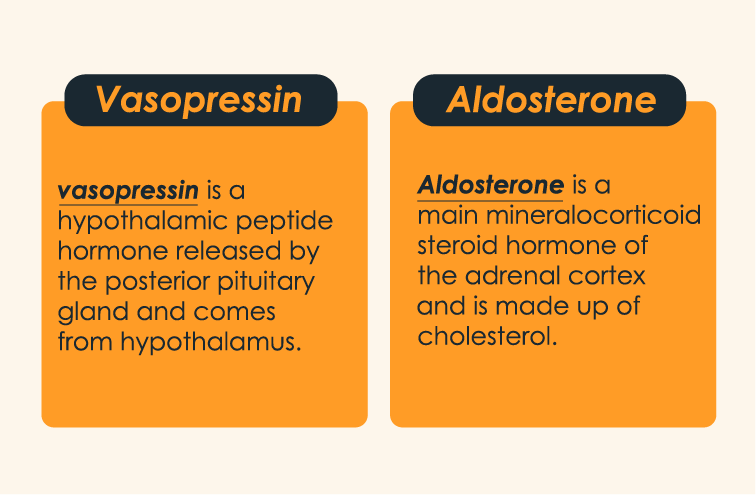
Vasopressin vs Aldosterone Differences, is aldosterone the same as vasopressin
aldosterone vs vasopressin vasopressin is a hypothalamic peptide hormone released by the posterior pituitary gland and comes from the hypothalamus. On the other hand, aldosterone is the main mineralocorticoid steroid hormone of the adrenal cortex and is made up of cholesterol.
The endocrine system contains a number of ductless glands that make chemical substances, which we called hormones. They take part in different chemical reactions and work separately in very low concentrations. Moreover, they can act as a catalyst. Generally, they are protein and only stored in the secretary glands or tissues.

adh vs aldosterone
What is Vasopressin?
Vasopressin is also known as the ADH (Anti-diuretic Hormone), argipressin, and arginine vasopressin (AVP). It is a neuro-secretary peptide hormone found in most mammals. This hormone comes from the hypothalamus and accumulates in the posterior lobe of the pituitary gland. From there ADH is secreted into the blood.
It contains nine amino acids such as phenylalanine, asparagine, tyrosine, proline, glycine, glutamine, cysteine, arginine, etc.
The structure of oxytocin and vasopressin are very similar. It is also a nonapeptide hormone with a disulfide bridge, and its amino acid sequence differs only in two positions.
The genes for oxytocin and vasopressin are located on the same chromosome and are separated in most cases by a relatively small distance.
The similarity of these two peptides can cause some cross-reactions: oxytocin has little antidiuretic activity, and high levels of ADH can cause uterine contractions.
It is generally accepted that vasopressin has two important physiological effects – antidiuretic and vasopressor. The first is associated with the retention of water in the body due to an increase in its reabsorption in the distal tubules and collecting ducts of the nephrons of the kidneys.
The second – with an increase in peripheral vascular resistance against the background of an increase in the volume of circulating blood due to fluid retention in the body. At the same time, under physiological conditions, the vasopressor effect of ADH does not prevail, since, with an increase in ADH secretion, blood pressure rises by no more than 5-10 mm Hg.
Functions of Vasopressin:
- It maintains the osmoregulation of the body.
- It is one of the hormones that regulate the excretion of water by the kidney.
- Through re-absorption capacity, vasopressin preserves water directly.
- The absence of vasopressin causes diabetes insipidus.
- It increases the water content in the body, increases circulating blood volume, and dilution of blood plasma.
- Vasopressin increases blood pressure. In high doses, ADH causes narrowing of the arterioles, which leads to an increase in blood pressure.
- It contracts and stimulates all the voluntary muscles in the body.
- In the brain, it is involved in the regulation of aggressive behavior. Its participation in memory mechanisms is assumed.
- It moves to the kidney through the blood and acts as chemical messengers.
What is Aldosterone?
Aldosterone is a hormone responsible for the retention of sodium salts and the excretion of potassium by the kidneys. The production of aldosterone is partly regulated by the adrenocorticotropic hormone of the pituitary gland and partly controlled by the kidneys. It is a mineralocorticoid steroidal hormone.
Aldosterone is the main hormone of the adrenal cortex in humans.
Two proteins, renin, and angiotensin regulate it. Angiotensin is aldosterone that is activated by a decrease in renal blood flow and a decrease in sodium intake into the renal tubules. Renin is released from the kidneys when blood pressure drops, blood sodium concentration decreases, or potassium concentration increases.
Aldosterone is mostly found in the blood in free form. Its action is manifested only after binding to mineralocorticoid receptors in the brain and liver. Metabolized in the liver and kidneys.
Functions of Aldosterone:
- The important function is maintaining normal blood sodium and potassium concentrations and in controlling blood volume and pressure.
- It causes an increase in the reabsorption of sodium and chlorine in the renal tubules, activating amiloride-sensitive sodium channels and Na-K-ATPase.
- Thus, aldosterone is involved in the regulation of electrolyte balance, maintenance of fluid volume, and blood pressure.
- Through the re-absorption of sodium ions (Na+), aldosterone preserves water indirectly.
- It influences carbohydrates, fats, and protein metabolism.
Is aldosterone a diuretic? Yes, aldosterone is diuretic and this can be one of the facts kidney manufacture more urine. It keeps the water level maintained by improving the potassium and sodium reabsorption in the kidney from the external cellular fluid.
Difference between aldosterone and vasopressin

| Vasopressin | Aldosterone |
| Vasopressin (ADH) is a peptide hormone. | Aldosterone is a steroid hormone. |
| It comes from the hypothalamus. | It is formed in the glomerular zone of the adrenal cortex. |
| ADH secreted when the body is dehydrated. | Aldosterone secreted when the blood pressure is low. |
| It averts the production of dilute urine. | It enhanced reabsorption of Na + in the distal tubules with its retention in the body and an increase in K + excretion with urine. |
| The secretion of the hormone increases with an increase in the osmolality of blood plasma and with a decrease in the volume of extracellular fluid. | The regulation of the synthesis and secretion of aldosterone is carried out mainly by angiotensin-II, which gave reason to consider aldosterone as part of the renin-angiotensin-aldosterone system, which ensures the regulation of water-salt metabolism and hemodynamics. |
| It increases the water permeability of the collecting ducts of the kidney. | It increases the tubular reabsorption of sodium cations, chlorine anions, at the same time increases the tubular excretion of potassium cations, and increases the ability of tissues to retain water. |
Similarities between vasopressin and aldosterone
- Both increase the water re-absorption.
- They work on the distal convoluted tubules and collecting tubules of the nephron.
- Both increase blood pressure
- Both secreted under low blood pressure.
Conclusion:
Both are two distinct hormones and have their own importance and working mechanisms in the body. Both possess their own biochemical importance while working in the body. Aldo is a key adrenal cortex steroid manufactured by cholesterol and Vaso pituitary gland hormone release from hypothalamus.